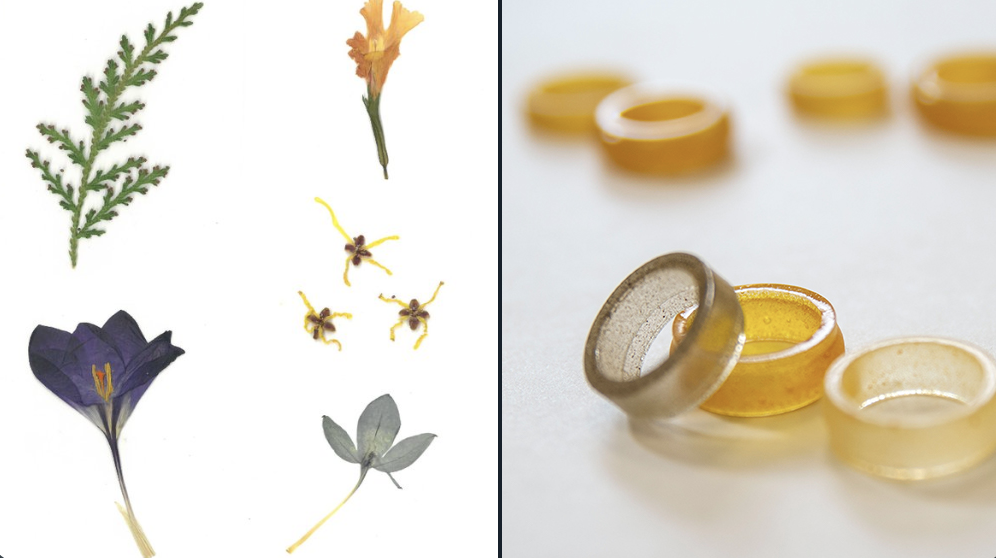
May 10, 2020

At the Arnold Arboretum. Photo: Fu-shuang Li/ Whitehead Institute
During his regular visits to observe the plants, Li became taken with the beauty of the flowers and ferns he was collecting, inspiring him to turn some of his research samples into art. In doing so, Li is contributing to a rich tradition of combining science and art—from historical scientific sketches to artistic modern microscopy—and following in the footsteps of other Whitehead scientists. On each collection trip, Li first takes the samples he needs for his research and then, with permission from the managers of the sites, he takes a few extra. He presses these extra flowers and ferns to preserve them. Not all 160 species lend themselves to pressing—some are too bulky, or fade and crumble instead of drying nicely. Li has turned the ones that did press well into small laminated cards.
“My favorites are the ferns,” Li says, looking through the collection of cards. “I think they are very beautiful.”
Several other members of Weng’s lab have aided Li in gathering the large number of specimens required for his research. In order to procure samples from all of the species that he needs, the group has collected not only from the Arnold Arboretum of Harvard University, but also from the Botanic Garden of Smith College and the University of Connecticut’s Ecology and Evolutionary Biology Greenhouse. Last year, Li designed baseball caps bearing images of pollen under an electron microscope. He gave one of these hats to Andrew Mitchell, the Weng Lab member who collected the most specimens, second to Li, last spring. This year, he plans to gift some of the flower-art cards to the people who assist him.

Photo: Conor Gearin/ Whitehead Institute
Li is using the many samples that he and his lab have collected to investigate sporopollenin, an impressively tough molecule that is found in both pollen and spores—small reproductive cells that ferns and other non-pollen bearing plants use to procreate.
“Among organic things, sporopollenin is one of the strongest you can find in nature,” Li says.

Photo: “Three Species Pollen Grains” by Asja Radja is licensed under CC-BY-4.0
The molecule’s toughness played a key role in plants’ evolutionary history. Plant life began in the ocean, and in order to make the jump to land, plants and their reproductive cells needed to be able to handle the terrestrial world’s harsh conditions, such as exposure to the sun’s UV radiation and drought. Sporopollenin’s chemical structure makes it incredibly durable, unreactive to its environment, and protective against UV; this gave spores, and later pollen, the protection they needed to survive on land. Besides its significance in the origins of terrestrial ecosystems, sporopollenin is an exciting blueprint for nature-inspired design. Li, Weng, and collaborators cracked the chemical structure of sporopollenin a few years ago. Using this information, researchers may be able to create products that mimic sporopollenin’s durability and inertness, for example in medical implants that need to stay intact and unreactive in patients’ bodies.

Pitch pine. Photo: “Pinus rigida cone Poland” by Crusier is licensed under CC BY 3.0
The researchers first identified the structure of sporopollenin in pitch pine. Now Li is investigating differences in the molecule across plant species, tracing the molecule’s evolution along with that of the plant kingdom—hence the need for his extensive collection trips. Weng and Li are especially interested in finding out how sporopollenin changed with the evolution of flowering plants in order to better understand the differences in pollen characteristics that arose alongside changes in plant structure and modes of pollination.
Sporopollenin’s hardiness, and the longevity it gives to pollen and spores, inspired Li’s next art project: pollen rings. Rings symbolize endurance, Li says—their perfect circles can represent eternity, or a life-long commitment to another person. Pollen grains, meanwhile, can stay intact for thousands or even millions of years. Pollen is abundant in fossil records and one of the first pollen rings that Li made contains fossil pollen from the Cretaceous Period, the age of dinosaurs.
“Pollen is special. The morphology survives for millions of years,” Li says. “So I always thought about the meaning of putting it in a ring.”

Photo: Conor Gearin/ Whitehead Institute
Li has also made rings using pine and lily pollen. Each type of pollen has its own color. The rings made of pine pollen are bright yellow, while the ones made with lily have a slightly purplish hue. Li creates the rings by mixing the pollen with resin and shaping the mixture in a mold. The rings are then hardened under UV light. Li observed a fun display of sporopollenin’s protective qualities during this process. The more pollen he mixed into a ring, the longer that ring would take to harden—he suspects because the sporopollenin absorbs UV. After the rings are hardened, Li sands and polishes them. He is saving the most carefully polished ring as a present for his wife.

Inspecting flowers at the Arnold Arboretum. Photo: Fu-shuang Li/ Whitehead Institute
As Li plans for his next round of collection trips this spring, he is also looking for his next art project. Unfortunately, due to the coronavirus pandemic, some of Li’s upcoming collection trips have been cancelled, meaning that he may miss his window to catch a few of the plants he needs in bloom. However, the Arnold Arboretum is still accessible, so sometime soon Li will tread the familiar, winding paths through the trees there, checking to see if the few remaining plants he needs for his research have bloomed and waiting for his next spark of inspiration to ignite, starting him on a new artistic endeavor.
Written by Greta Friar
